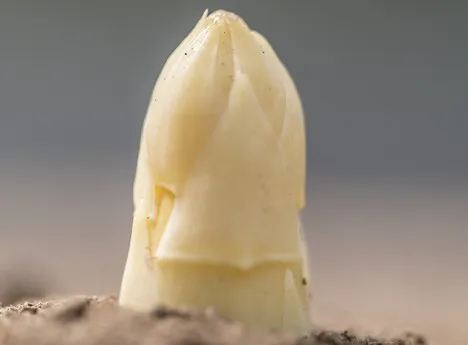After a winter cold snap, storms and few hours of sunshine, the sun appears more often at the start of spring. For most farms, the asparagus season begins at the end of March, the farm stores open, and at Easter most southern German producers will be selling asparagus. In central and northern Germany, the noble vegetable is still somewhat delayed due to night frosts and a lack of sun, so that only small quantities can be expected at Easter.
"Despite anticipation of the asparagus season, harvesting under pandemic conditions is a major challenge for farms. Elaborate infection control and hygiene concepts have been implemented in preparation for the season. However, many farms are worried about the entry of their harvest workers from Eastern Europe in view of rising infection figures throughout Europe. After the experiences of the first lockdown, we appeal to the political decision-makers to guarantee entry into the country in all cases and to extend the duration of short-term, social security-free employment in order to avoid a change of personnel during the season and thus an increased risk of infection in the farms," says Simon Schumacher, Chairman of the Board of the Association of Southern German Asparagus and Strawberry Growers (Verband Süddeutscher Spargel- und Erdbeeranbauer e.V.).

Fresh asparagus / Image: VSSE
Cold winter days strengthened plants, so sprouting was good
Asparagus expert Dr. Ludger Aldenhoff gives a positive summary with regard to the past winter and asparagus growth: "The cold weather in February came through and has had a positive effect on the asparagus, so that we can expect quality asparagus. The good news is that due to the good weather forecasts, most growers will have local asparagus before and at Easter."
Nils Kraushaar, asparagus cultivation advisor from the Lower Saxony Chamber of Agriculture, is also optimistic about the season: "Currently, we still have overcast weather and night frosts in Lower Saxony. Thanks to the nice cold temperatures, we expect a good and lush budding of the asparagus shoots as soon as the sun appears. At Easter, we expect asparagus, but in small quantities."
Reopened gastronomy sector is important for asparagus sales
The season has gotten off to a good start, according to Michael Koch, deputy division manager and asparagus market expert at Agrarmarkt Informations-Gesellschaft (AMI). "The first asparagus from heated cultivation was well received by asparagus lovers. The course of the season depends, of course, strongly on the reopening of the gastronomy industry." According to the Agrarmarkt Informations-Gesellschaft, the self-sufficiency rate for asparagus was 85 percent last year. It is one of the few vegetables produced and also consumed to this high degree in Germany. In 2020, demand for white and green asparagus stood at a ratio of 85 percent white asparagus to 15 percent green asparagus, shifting one percentage point in favor of green asparagus.
Review of the 2020 season
According to the Federal Statistical Office, the 2020 asparagus harvest across Germany was 10 percent lower than last year, with a crop of around 117,653 tons. In the last six years, an average of around 123 700 tons of asparagus could be harvested per year. This means that the 2020 harvest volume is around 5 percent below this average. The area of asparagus in production has decreased by around 2 percent compared to the previous year, from 22,975 hectares to around 22,409 hectares.
In addition to the smaller harvested area, this decline in harvest volume is also due to the fact that, as a result of the Corona pandemic, foreign harvest workers were absent in some regions and therefore not all asparagus areas could be harvested.
At 5.25 tons per hectare, the yield showed a decline of almost 8 percent compared to 2019. In Germany, there were a total of 1598 asparagus farms last year (2019: 1660 farms), cultivating a total of 25,880 hectares (including young plants), which corresponds to a roughly 5 percent smaller cultivation area than in 2019 with a simultaneous decrease in growers of almost 4 percent. These figures are continuing last year's downward trend.
For more information: www.vsse.de
